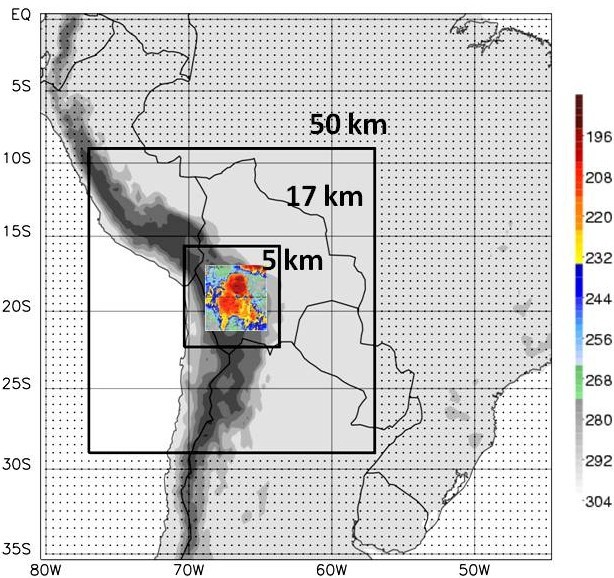|
CLIMATE RESEARCH GROUP
Large scale climate impacts on Bolivia's Altiplano
In this project we want to understand how large scale climate forcings (e.g., from
ENSO
or climate change) interact with local land-surface conditions and produce regional climate forecast skill over the Bolivian
Altiplano
Performing realistic simulations over this region is challenging because of the complex topography, finescale variations in land-cover, and the importance of cold climate processes related to the presence of snow, ice, and glaciers.

Setup of the doubled nested regional model. The inner domain, centered over the Bolivian Altiplano, has a spatial resolution of 5.5 km (100 x 110). The 17 km outer domain (100 x 110) is nested into the 50 km grid of the CFSRR reanalysis (black dots). The color insert shows brightness temperatures of a mesoscale system that passed the Altiplano on 02/27/2008. The data have a pixel resolution of 4 x 4 km and were derived from the TRMM instrument (pers. comm. Chuntao Liu, U. of Utah).
We have chosen this extreme region because (1) it is the perfect study ground for cold season and high-elevation land-surface processes and their role in climate, (2) it is located in the inner tropics where the ENSO impacts are strong, and (3) it is in strong need of a weather and climate forecast capability to be able to predict changes in the region's water supply due to ENSO and climate change.
This
video
from the Worldbank explains how climate change related melt of glaciers in the Andean region threatens the water supplies of the local Indian population.
The principal research tool of this project is a high-resolution version of the Weather and Research Forecasting
(WRF)
model. The model will be specifically configured to better simulate the cold season and high terrain processes that are typical for the study region. The model will be driven at its boundaries by global reanalyses, climate model data, or existing ensemble hindcasts of the
NCEP's
Climate Forecast System
CFS.
This project is carried out in close partnership between the University of Utah and scientists at Bolivia's major state University, Universidad Mayor de San Andres
(UMSA).
Further reading
Ramirez, E., B. Francou, P. Ribstein, M. Descloitres, R. Guén, J. Mendoza, R. Gallaire, B. Pouyaud, and E. Jordan, (2001):
Small glaciers disappearing in the tropical Andes: a case-study in Bolivia: Glaciar Chacaltaya (16S),
J. Glac., 47, 187-194(8).
[an error occurred while processing this directive]
Wednesday, 26-Feb-2014 12:39:12 MST
|